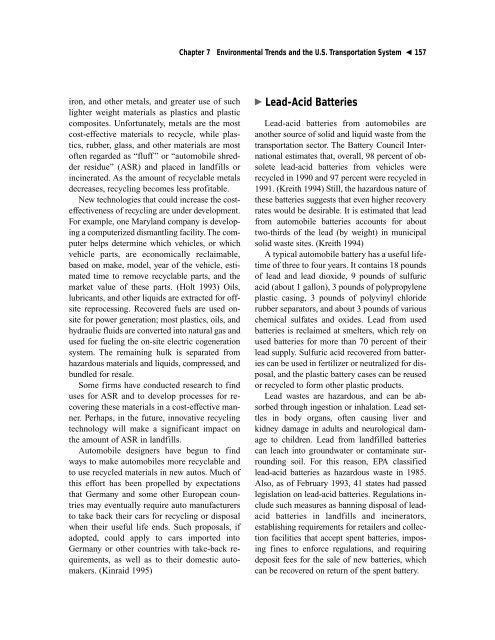table of contents - Research and Innovative Technology ...
table of contents - Research and Innovative Technology ...
table of contents - Research and Innovative Technology ...
Create successful ePaper yourself
Turn your PDF publications into a flip-book with our unique Google optimized e-Paper software.
iron, <strong>and</strong> other metals, <strong>and</strong> greater use <strong>of</strong> such<br />
lighter weight materials as plastics <strong>and</strong> plastic<br />
composites. Unfortunately, metals are the most<br />
cost-effective materials to recycle, while plastics,<br />
rubber, glass, <strong>and</strong> other materials are most<br />
<strong>of</strong>ten regarded as “fluff ” or “automobile shredder<br />
residue” (ASR) <strong>and</strong> placed in l<strong>and</strong>fills or<br />
incinerated. As the amount <strong>of</strong> recyclable metals<br />
decreases, recycling becomes less pr<strong>of</strong>i<strong>table</strong>.<br />
New technologies that could increase the costeffectiveness<br />
<strong>of</strong> recycling are under development.<br />
For example, one Maryl<strong>and</strong> company is developing<br />
a computerized dismantling facility. The computer<br />
helps determine which vehicles, or which<br />
vehicle parts, are economically reclaimable,<br />
based on make, model, year <strong>of</strong> the vehicle, estimated<br />
time to remove recyclable parts, <strong>and</strong> the<br />
market value <strong>of</strong> these parts. (Holt 1993) Oils,<br />
lubricants, <strong>and</strong> other liquids are extracted for <strong>of</strong>fsite<br />
reprocessing. Recovered fuels are used onsite<br />
for power generation; most plastics, oils, <strong>and</strong><br />
hydraulic fluids are converted into natural gas <strong>and</strong><br />
used for fueling the on-site electric cogeneration<br />
system. The remaining hulk is separated from<br />
hazardous materials <strong>and</strong> liquids, compressed, <strong>and</strong><br />
bundled for resale.<br />
Some firms have conducted research to find<br />
uses for ASR <strong>and</strong> to develop processes for recovering<br />
these materials in a cost-effective manner.<br />
Perhaps, in the future, innovative recycling<br />
technology will make a significant impact on<br />
the amount <strong>of</strong> ASR in l<strong>and</strong>fills.<br />
Automobile designers have begun to find<br />
ways to make automobiles more recyclable <strong>and</strong><br />
to use recycled materials in new autos. Much <strong>of</strong><br />
this effort has been propelled by expectations<br />
that Germany <strong>and</strong> some other European countries<br />
may eventually require auto manufacturers<br />
to take back their cars for recycling or disposal<br />
when their useful life ends. Such proposals, if<br />
adopted, could apply to cars imported into<br />
Germany or other countries with take-back requirements,<br />
as well as to their domestic automakers.<br />
(Kinraid 1995)<br />
Chapter 7 Environmental Trends <strong>and</strong> the U.S. Transportation System � 157<br />
� Lead-Acid Batteries<br />
Lead-acid batteries from automobiles are<br />
another source <strong>of</strong> solid <strong>and</strong> liquid waste from the<br />
transportation sector. The Battery Council International<br />
estimates that, overall, 98 percent <strong>of</strong> obsolete<br />
lead-acid batteries from vehicles were<br />
recycled in 1990 <strong>and</strong> 97 percent were recycled in<br />
1991. (Kreith 1994) Still, the hazardous nature <strong>of</strong><br />
these batteries suggests that even higher recovery<br />
rates would be desirable. It is estimated that lead<br />
from automobile batteries accounts for about<br />
two-thirds <strong>of</strong> the lead (by weight) in municipal<br />
solid waste sites. (Kreith 1994)<br />
A typical automobile battery has a useful lifetime<br />
<strong>of</strong> three to four years. It contains 18 pounds<br />
<strong>of</strong> lead <strong>and</strong> lead dioxide, 9 pounds <strong>of</strong> sulfuric<br />
acid (about 1 gallon), 3 pounds <strong>of</strong> polypropylene<br />
plastic casing, 3 pounds <strong>of</strong> polyvinyl chloride<br />
rubber separators, <strong>and</strong> about 3 pounds <strong>of</strong> various<br />
chemical sulfates <strong>and</strong> oxides. Lead from used<br />
batteries is reclaimed at smelters, which rely on<br />
used batteries for more than 70 percent <strong>of</strong> their<br />
lead supply. Sulfuric acid recovered from batteries<br />
can be used in fertilizer or neutralized for disposal,<br />
<strong>and</strong> the plastic battery cases can be reused<br />
or recycled to form other plastic products.<br />
Lead wastes are hazardous, <strong>and</strong> can be absorbed<br />
through ingestion or inhalation. Lead settles<br />
in body organs, <strong>of</strong>ten causing liver <strong>and</strong><br />
kidney damage in adults <strong>and</strong> neurological damage<br />
to children. Lead from l<strong>and</strong>filled batteries<br />
can leach into groundwater or contaminate surrounding<br />
soil. For this reason, EPA classified<br />
lead-acid batteries as hazardous waste in 1985.<br />
Also, as <strong>of</strong> February 1993, 41 states had passed<br />
legislation on lead-acid batteries. Regulations include<br />
such measures as banning disposal <strong>of</strong> leadacid<br />
batteries in l<strong>and</strong>fills <strong>and</strong> incinerators,<br />
establishing requirements for retailers <strong>and</strong> collection<br />
facilities that accept spent batteries, imposing<br />
fines to enforce regulations, <strong>and</strong> requiring<br />
deposit fees for the sale <strong>of</strong> new batteries, which<br />
can be recovered on return <strong>of</strong> the spent battery.

















